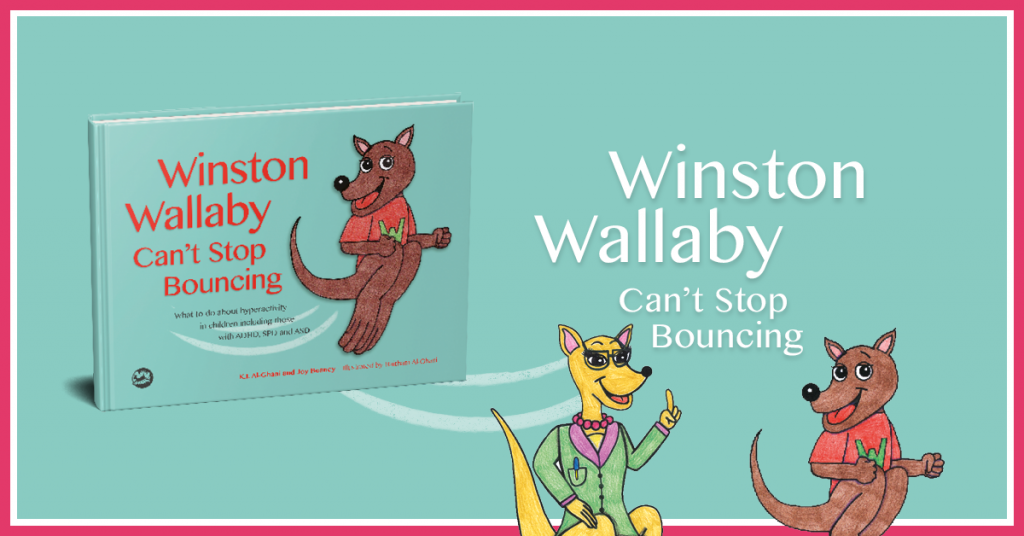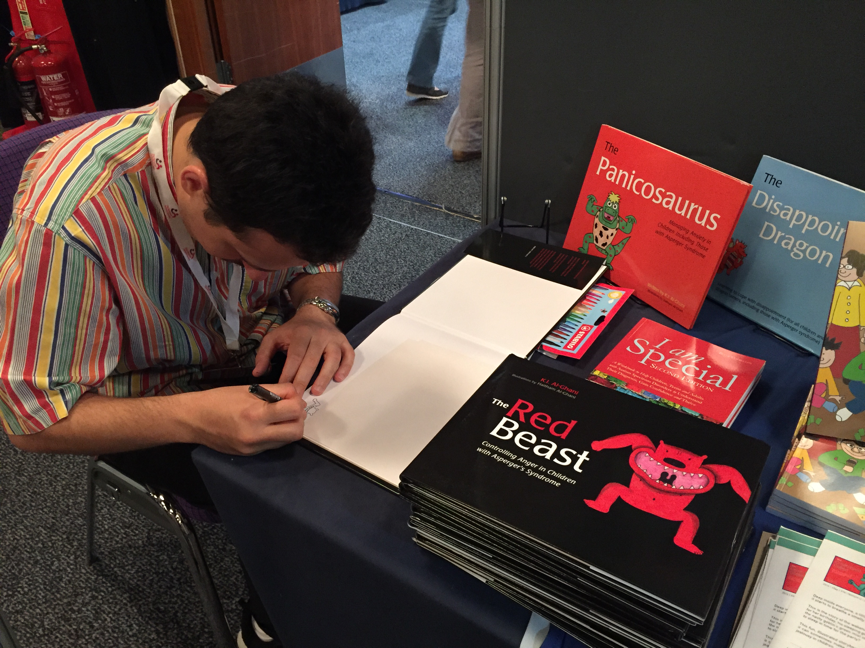Winston Wallaby Can’t Stop Bouncing is a fun, illustrated storybook that will help children aged 5-10 with Attention Deficit Hyperactivity Disorder (ADHD), Sensory Processing Disorder (SPD) and/ or Autism Spectrum Conditions (ASC/ASD) to recognise their sensory needs and to develop tools to support them. To learn more about the book, who better to ask than its authors, K.I. Al-Ghani and Joy Beaney? Chatting to them, we learned a lot about hyperactivity in children, what to look out for and what can help. There’s even a downloadable activity sheet for teachers. Read on to find out more.
What motivated you to write Winston Wallaby Can’t Stop Bouncing and who is the book for?
Joy and I have worked together in special education for many years. We noticed that there were not many books available that could explain hyper-activity to children in a story format. We decided to collaborate on this project using Joy’s expertise in Sensory Processing Difficulties, my skills as a story teller and Haitham’s ability to bring it all to life, through his illustrations.
We think the book has something for everyone: It is a story all children can enjoy. A story in which, we hope, children with hyperactivity will be able see themselves in Winston. They will learn that it is not their fault and instead of being the problem, they could learn to be part of the solution. Parents and educators will have tools and strategies they can use that can help the child to manage their hyperactivity and, if successful, perhaps avoid the need for medication.
What will children gain from reading the book?
All children, not just those with Hyperactivity, can benefit from this book. Children with Sensory Processing Difficulties, struggling to cope in a busy classroom will find a kindred spirit in Winston. They will get a better understanding of why they find it hard to sit and learn and what they can do to help themselves. With understanding comes confidence and better self-esteem. Typical children will recognise the child with hyperactivity in their own classroom. The classmate they think of as being quite naughty and sometimes rather silly, can now be seen through different eyes. We hope it will foster empathy and understanding, making typical children less judgemental and more supportive.
(Click here to download suggested teacher’s activities to use with the book)
Kay, can you tell us a little bit about your own background and how you came to be interested in the subjects you write about?
Hyperactive Children often receive more than their fair share of criticism and disapproval. Hyperactivity was one of the first things I noticed about Haitham (my son and the illustrator) before we got a diagnosis of Autism. He was constantly on the go. Incapable of sitting still or concentrating on anything for more than a couple of minutes.
“Why can’t you sit still?”
“For goodness sake –stop it!”
“Put that down this instant!’

These are the phrases of exasperation I would use regularly with Haitham, until I realised that something was very wrong. That something was Autism. Critical friends and relatives labelled him “naughty”. Sympathetic friends and relatives said not to worry he was “just a boy!” I was blamed for not taking him out enough and for not being strict enough. The truth was, I couldn’t take him anywhere – he would climb up on anything – with no regard for danger or social niceties. His ever moving and curious little fingers would be into everything –ladies’ handbags, other people’s cupboards and drawers, anything electrical. Life became so stressful and I would often be exhausted and quite tearful by the end of the day.
When Haitham got a diagnosis of Autism – I, like many mothers, embarked on a quest to find out as much as I could about this enigmatic condition. This knowledge enabled me to use my skills as a teacher, to help, not only my own son, but other children with Autism and associated learning difficulties like ADHD /ADD , Sensory Processing Difficulties and Dyslexia. It is as much a passion today as it was 30 years ago when I was learning how to get the best out of school and life for Haitham. He is now 32 and quite the most wonderful son any mother could wish for. He has channelled his hyperactivity into walking and gardening and can now chill out with the best of us!
How does this book fit in with the other books you’ve written, on the topics of helping children to manage feelings of anger, jealousy, disappointment etc.
In all my books, I use the magic of the metaphor to explain to children their particular emotions or difficulties. By introducing a character, it de-personalises the situation and enables the children to see themselves from the outside, without judgement or blame. Over the years I have heard many children say:
“I am just like that” –or “that is just like me!”
As soon as I hear these words, I know we have opened the door to further dialogue and magical teaching moments. I hope this is true for all the parents and professionals who use and recommend the books. I always include teaching strategies and I am very excited to have Joy on board to do this with our little Winston Wallaby.
And Joy, what about you, can you tell us a little bit about your background?
I have had many years’ teaching experience in both mainstream and special education. During my career, I have been an Assistant Head at a special school and manager of an Inclusion Support Service that provided staff training and support for children in mainstream schools. I set up ‘Autism Train’, which is an independent specialist organisation, which provides high-quality autism training courses, support and mentoring. Autism Train specialises in providing high quality training for families, educational settings and organisations so that people can make a positive difference to the lives of people with autism.
My research and practice focuses on developing an insight into how people with autism learn and interpret the world around them and this was further developed through my research into the impact of sensory difficulties in children with autism. I felt it was important to raise awareness of the possible significance of sensory difficulties on the child’s learning and behaviour and I developed and published a sensory assessment and intervention programme as well as books on strategies to support autistic children.

From speaking to children with hyperactivity, sensory processing difficulties or autism, we know that they can sometimes find the world overwhelming. The classroom and playground can be overwhelming places for all children, so with the added struggle for these children of trying to focus, concentrate and complete tasks that they find particularly challenging, it is easy to see why their academic, personal and social development can be affected. But of course, this needn’t and shouldn’t be the case.
It is only when children are in an appropriate state, physically and emotionally, that they are ready to learn. Rather than putting the onus on these children to “fit in” with school and society, we owe it to them to ensure that school staff will recognise, and empathise with their particular challenges, without losing sight of their individual personalities and talents. Only in this way will we be able to cultivate an inclusive and accepting society that truly embraces and celebrates difference.
How can we tell when hyperactivity in a child goes beyond what’s expected and starts to become a problem for them?
Toddlers and young children are bundles of energy and frequently flit from one activity to another. However, as children get older their concentration span develops. School staff may be the first to recognise that the child is hyperactive in comparison to their classmates. This is because in school, more demands are placed on the child to sit still, concentrate and follow the teacher’s instructions. If the child is hyperactive and unable to keep still and concentrate it can increase their anxiety, not understanding why they find things so difficult and other children do not. Parents and teachers can find it very exhausting dealing with a child who is on the move from the moment they wake up, to the moment they eventually get to sleep. If people do not understand the reason behind this behaviour, they may become annoyed with the child and think the behaviour is somehow planned to irritate and upset them.
What’s your advice for supporting a hyperactive child?
- If your child is displaying signs of hyperactivity, you should speak to your doctor who will determine the underlying cause of the symptoms and what type of help your child needs.
- Working in partnership with the school will help to develop a consistent approach and enable the school to put in place help to make the child happy and successful.
- Become a detective – Observe and see if you can spot triggers. Does your child become more hyperactive at different times, in different situations or with different people? Spotting patterns to the behaviour and identifying triggers means you will be more able to find ways to help. You can then be proactive and try strategies to prevent the behaviour occurring rather than just reacting to it afterwards.
- Always encourage the child to do some physical exercise before any activity that requires sustained concentration such as homework.
- Consider the impact of the environment on the child and create an area they can go to that will support their sensory needs. This could be their bedroom, a pop up tent or even under the table. Use things to help calm the child such as dimmed lighting, favourite fabrics, mood lights and soft toys. Include a box full of favourite calming activities such as colouring books, comics, bubbles and fidget toys.
If you would like to read more articles like this and get the latest news and offers on our books about autism, why not join our mailing list? We can send information by email or post as you prefer. You may also be interested in liking our Autism, Asperger’s and related conditions Facebook page.